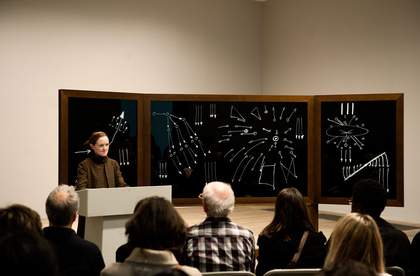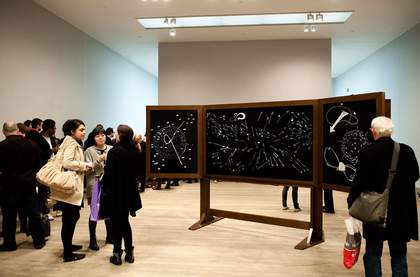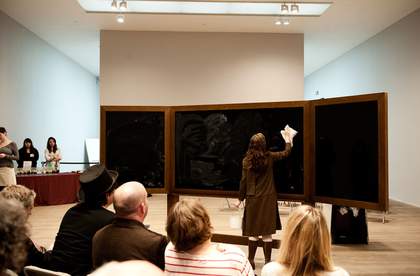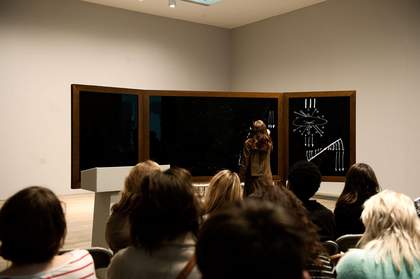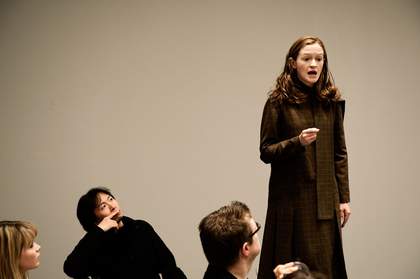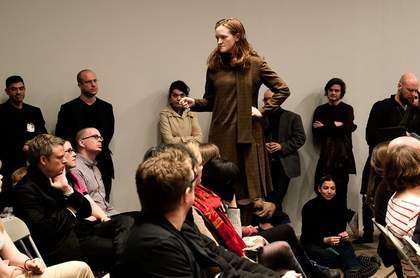The performance of The Infinite Repetition of Revolt at Tate Modern in March 2011 began with the audience entering the gallery, which was empty apart from a large object resembling two freestanding blackboards positioned back-to-back. It was actually constructed of beech and black glass marked with neat and orderly diagrams. On one side were circles, arrows and lines, suggesting patterns of movement or flow, while the other side showed similar, though more sweeping, patterns of arrows, dots and curved lines.
Members of the audience were offered wine and allowed to move freely across the room, to mingle as though at a cocktail party, until actress Maggie McBrien and a number of volunteers appeared and began to arrange two rows of chairs in front of one side of parallel blackboards. As the audience were asked to take their seats, McBrien moved to a podium that had been placed in front of the blackboard sculpture. She then performed a speech ‘Warning to the People’ (1851) delivered by the political activist Louis Auguste Blanqui (1805–1881), which set out his belief that revolution should be undertaken by a small, elite group who would overthrow the ruling class and establish a temporary dictatorship for the good of the people.
Following the completion of this speech, McBrien and the volunteers moved to the other side of the sculpture and began to set up a second set of chairs, again in rows, until it reflected the set-up on the opposite side of the board. The audience was encouraged to move across the room and take seats on the opposite side, facing a near identical staging of the blackboard sculpture and podium. McBrien then delivered a speech standing on a chair from within the audience, rather than at the podium. This second speech, titled ‘Our Program and the Political Situation’, was written in 1918 by Rosa Luxemburg (1871–1919), a political activist and theorist of socialist revolution. In contrast to Blanqui, Luxemburg believed in the activation of the working classes and advocated mass participation in any revolution. After delivering this speech McBrien took a cloth and began to systematically clean the diagrams from the blackboards, first on one side, then the other. She then left the performance area and started informal conversations with small groups of audience members, before delivering a final, short Blanqui-inspired speech and ending the performance, which lasted one and a half hours in all.
The Infinite Repetition of Revolt sought to enliven two historic texts about unrealised revolutions, opening them up for discussion and debate. The choreography of the performance also gestured to the differences between these revolutionary positions. While Blanqui’s defence of revolution led by an elite was delivered from a position of power, protected by the podium and flanked by the blackboard and diagrams, Luxemburg’s words came from among the crowd, with a sense of spontaneity and camaraderie. The performance, for Geyer and McElheny, was a space to disseminate ideas, particularly ones relating to activism and politics, and to investigate how those ideas were anchored in, or related to, understandings of space itself as socially significant.
The Infinite Repetition of Revolt formed part of the series Tate Modern Live: Push and Pull, which was inspired by Alan Kaprow’s performance environment Push and Pull: A Furniture Comedy for Hans Hoffman 1963. In this piece Kaprow installed furniture in two rooms, and allowed the public to rearrange it in accordance with a set of instructions. The subtitle of the piece referred to the painter Hans Hoffman, who taught many of the most distinguished American artists of the mid-twentieth century, including Kaprow. Hoffman used the phrase ‘push and pull’ to describe how a painter should create movement within a painting using contrasts of colour, form and texture. Kaprow repurposed this phrase from its original application in relation to painting and applied it to performance, transposing this theory from the flat canvas into a three-dimensional social space. The idea of expanding the use and implications of theory was central to the two-day Push and Pull event at Tate. Nine artists were invited by Tate, Tanzquartier Wien and Museum Moderner Kunst (MUMOK) in Vienna to investigate and explore history and theory through the medium of performance.1
The performances often incorporated elements of more traditional art media, such as sculpture, theatre and painting, to explore performance as a hybrid medium which often deals with issues, concepts and theories that could sometimes be seen as falling between traditional categories.
Acatia Finbow
October 2015


